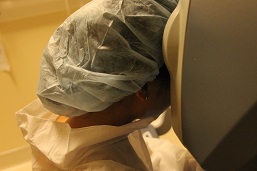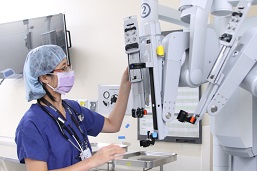Services
Dr Zhou provides a variety of services such as obstetrics, gynecological and minimal invasive surgical services, including robotic minimal invasive surgeries. Dr. Zhou’s top priority is her patients’ wellbeing and safety. She will provide the best care you can find.
Obstetric services:
- A full term pregnancy lasts for 40 weeks and time is divided into three trimesters.
- The first trimester is the time period before the 13th week.
- The second trimester is the time period between the 14th week through the 27th week.
- The third trimester lasts from the 28th week through the 40th week.
Obstetrics services includes:
- Prenatal care.
- Vaginal delivery or cesarean section and postpartum care.
- Diet education, vaccination, travel, exercise suggestions during pregnancy.
- Coordinated care with other specialists for any problems during pregnancy.
- Circumcision if parents desire.
General gynecologic services:
Dr. Zhou provides a variety of Gynecological services including but not limited to:
- Routine pelvic exam; cervical cancer screening; breast cancer screening; osteoporosis screening, treatment, and prevention; diet education and weight control
- Follow up and treatment for abnormal pap smear
- Education and preventive care for young women and teens, such as contraception, sexual transmitted diseases prevention; HPV vaccine, etc.
- Perimenopausal and postmenopausal diseases; hormone replacement therapy
- Diagnosis and treatment for all diseases arising from female organs, such as abnormal uterine bleeding, abnormal menses, ovarian cysts, pelvic pain, etc.
- Benign uterine or ovarian tumors
- Sexual dysfunction
- Infertility work ups; ovulation induction, IUI
- Pelvic floor dysfunction; dyspareunia, vaginismus; uterine prolapse; urge or stress urinary incontinence
- Perimenopausal and postmenopausal diseases, hormone replacement therapy
Gynecological procedures:
There are multiple ways to treat the same disease. You should look into the details of the risks and the benefits of all of the options for treating your diseases. Some procedures carry a relative higher risk, but they also result in greater benefits. Others may be very simple office procedures with minimal risks. You should ask yourself the following two questions before you make your decision:
- Does the procedure have more benefits than risks?
- Whether or not the risks are acceptable? Therefore you can make an informative decision for yourself after your discussion with Dr. Zhou.
Two common mistakes that people make:
1. Deny any surgical options due to fear of the risks associated with them. This extremely conservative approach will cause unnecessary risks or damage caused by the disease.
2. Desire the most effective treatment and always consider the surgical option her first choice. This overly aggressive approach will cause unnecessary exposure to the risks caused by the procedure.
After you compare the risk and benefit of all the options for treatment of your disease(s), you can decide what type of treatment is best for you per your specific situation. Treatment can be medical treatment with some medications or surgical treatments. Also observation without taking anything or just following up with tests is also considered treatment.
Surgical procedures include minor treatments which can be done in the office or major ones which need to be done in the operating room. Minor gynecological procedures carry lower risks. Major procedures normally need to be done in a hospital operating room under general anesthesia. Major procedures normally carry higher surgical risks and may need hospitalization for observation 1 to 3 days after the surgery.
After you decide which method to choose, Dr. Zhou will provide the options of how to carry out the treatments. If the treatment has low risks, it might be easier to make a decision. However, if the treatment involves a major procedure, it might take some time to decide how and when to carry it out.
For example, hysterectomy is a common major gynecological procedure to treat heavy, prolonged vaginal bleeding. There are two ways to perform a hysterectomy: a laparotomy–an incision like a cesarean section is made in order to remove the uterus from abdomen, versus a minimal invasive route to do the same surgery in which a few less than 1 cm incisions are made to remove the uterus from the vagina, resulting in less pain and a faster recovery.
However, not everyone can be a candidate for the minimal invasive procedure, and every doctor’s comfort zone to do the minimal invasive procedure varies. Generally speaking, minimal invasive procedures require more advanced surgical techniques, as well as extra training and experience.
The the Da Vinci Robot tool allows more patients to enjoy the minimal invasive treatment for more advanced diseases. Since the Da Vinci Robot became available, the laparotomy rate decreased to 50%. Some large uterus can be removed without cut patient open, some myomectomy can be done with minimal incisions too. Since the Da Vinci Robot cost for initial equipment and hospital surgical staffs training, Not every hospital can afforded. Mills-Peninsula has invested on Da Vinci to better serve the population in peninsula.
Office procedures:
* LEEP, D&C, IUI, implanon, IUD insertion and removal, include Chinese ring IUD removal in office, office simple urodynamic study
Major Gynecological procedures:
- hysterectomy
- Myomectomy
- Ovarian cystectomy
- Removal ovarian benign tumor
- Endometriosis
- Tubaligation
- Vaginal wall prolapse anterior and posterior repair; work with pelvic reconstruction specialist for vaginal wall suspension and incontinence treatment
Minimal invasive Gynecological procedures
Dr. zhou is one of the few gynecologists who had completed Da Vinci Robotic training and is qualified to perform Robotic gynecological procedure in this area. She has performed minimal invasive hysterectomy for uterus about 16 weeks in size. Patients have the least complaints of postoperation pains after DaVinci Robotic Hysterectomy, and resume driving as well as other daily activities about 2-4 weeks earlier than traditional abdominal hysterectomy.
Robotic assisted myomectomy, endometriosis diagnosis and lesion resection,
Laparoscopically assisted vaginal hysterectomy; ovarian cystectomy, endometriosis; chromotubation;
Vaginal hysterectomy, salpingooophorectomy
Hysteroscopically myomectomy; endometrial ablations as HTA, Novasure, Thermochoice ablations, Essure



